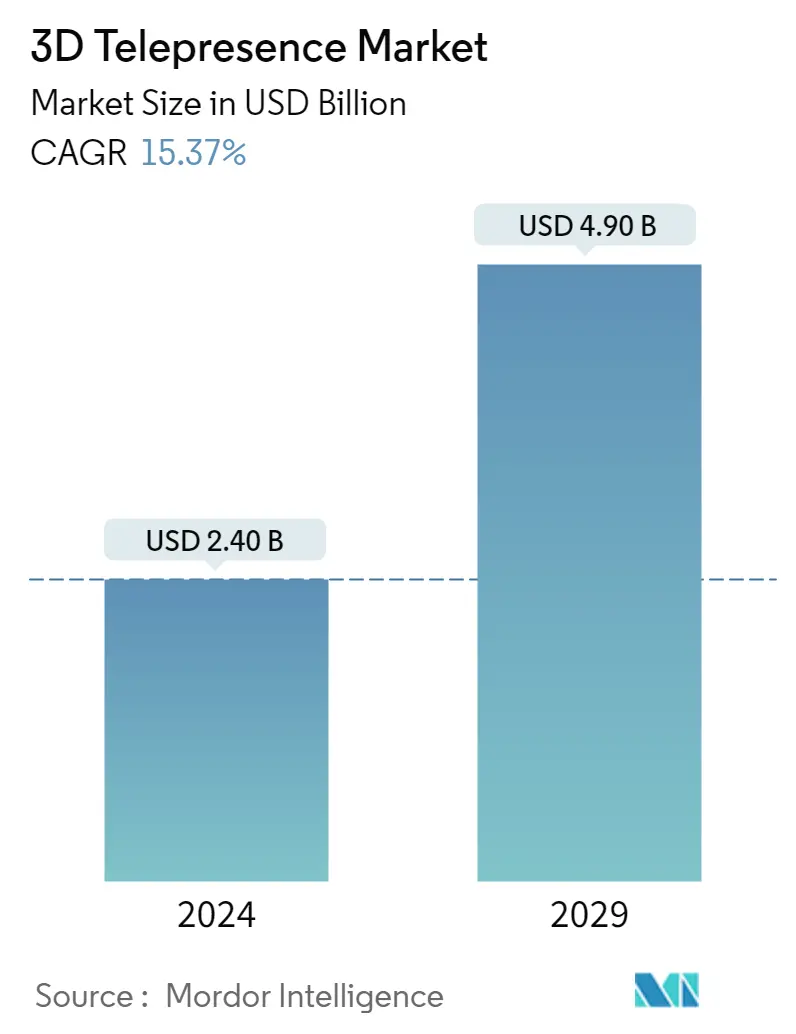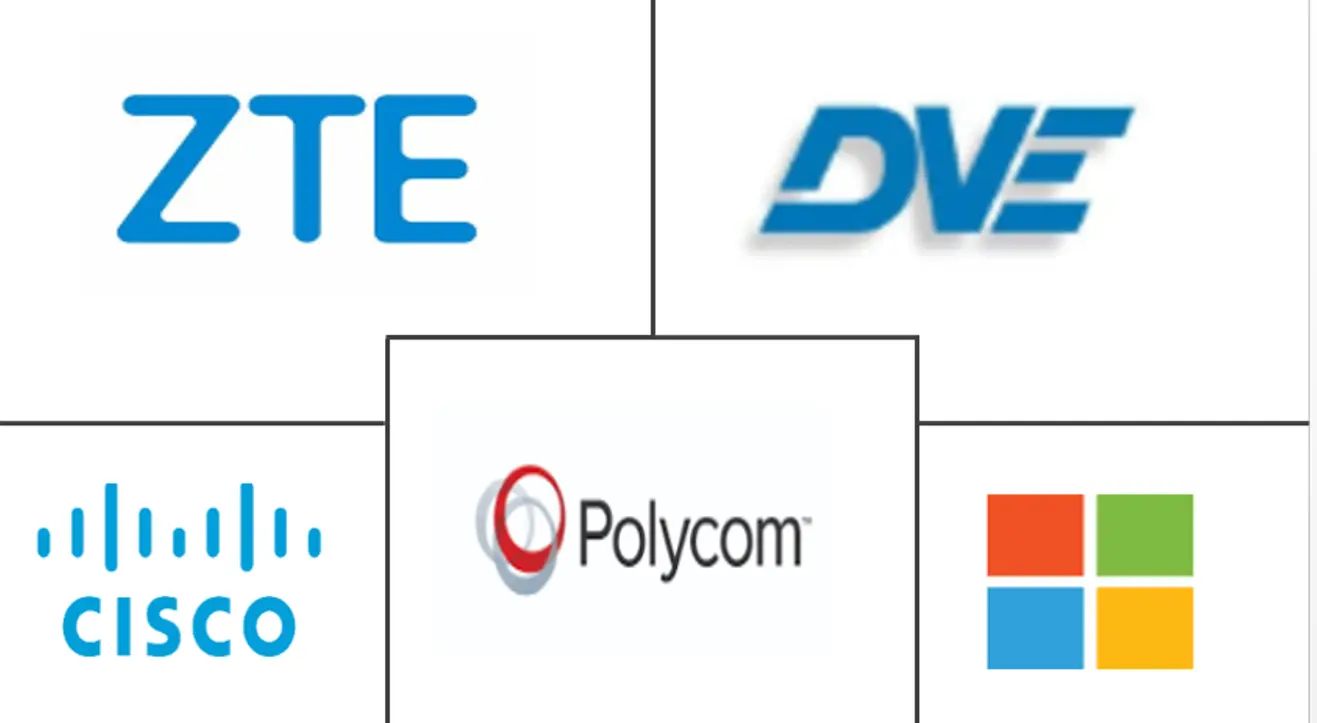Market Size of 3D Telepresence Industry

| Study Period | 2019 - 2029 |
| Market Size (2024) | USD 2.40 Billion |
| Market Size (2029) | USD 4.90 Billion |
| CAGR (2024 - 2029) | 15.37 % |
| Fastest Growing Market | Asia Pacific |
| Largest Market | North America |
Major Players
*Disclaimer: Major Players sorted in no particular order |
3D Telepresence Market Analysis
The 3D Telepresence Market size is estimated at USD 2.40 billion in 2024, and is expected to reach USD 4.90 billion by 2029, growing at a CAGR of 15.37% during the forecast period (2024-2029).
- The growing adoption of advanced technologies, such as AR and MR, is expected to pave the path for a new collaborative platform called 3D telepresence. The increasing adoption of advanced technologies, such as AR and MR, is expected to pave the way for a new collaborative platform called 3D telepresence.
- Audio and visual applications like Google Hangouts, Facetime, Skype, and other video conferencing platforms for offices exist today for use across enterprises to enable remote communication.
- Although the quality of experience, concerning audio and visual transmission, has significantly improved over the years, 2D video technology has several inherent drawbacks, like loss of non-verbal cues, such as eye contact and gestures, which cannot be mitigated easily. Some of these issues are addressed by 3D telepresence, which provides rendering and streaming of 3D video data between two or more parties, boosting the adoption of 3D telepresence globally.
- While intelligent conference rooms are being developed by companies like Cisco (Spark system), a bundle of cameras, 4K screen speakers, and supporting devices, technology advancements result in more life-like experiences through telepresence.
- Cisco, Microsoft, Teliris, Huwaei, and Sony are among the early entrants in the telepresence space. Since its inception, the technology has overcome a few challenges, such as interoperability between telepresence systems from different vendors and compatibility with networks provided by various telecom companies.
- The technology has been showcased in several entertainment demonstrations, like Musion 3D. However, to date, the practical applications have been limited by the high cost of such 3D systems compared to 2D telepresence/video conferencing.
- The remote consumer's digital representations could be rendered over the real by taking advantage of recent advances in augmented reality (AR), coupled with 3D, such as Atheer air Glasses, Google Glass, and Microsoft hololens world, creating a mixed-reality experience. Following the COVID-19 pandemic, trends such as remote working and the need for immersive experiences were expected to gain momentum. In such a regard, 3D telepresence systems were crucial in ensuring workflow.
3D Telepresence Industry Segmentation
3D TelePresence achieves actual depth without the usage of 3D glasses. An individual from a different part of the world can appear life-size inside the space for real-time two-way dialogue while maintaining eye contact.
Moreover, this technology is the emergence of new communication techniques. Consulting firms widely use this to provide personalized service to their clients that cannot be provided by phone, email, or any other standard video. It is capable of bringing renowned specialists from multiple countries at the same time. The scope of the market includes Solution Type Hardware and Software, applications including Education, Advertising, Conferencing, and Customer Service, among others.
The 3D Telepresence Market is Segmented by Solution Type (Hardware and Software), Application (Education, Advertising, Conferencing, Customer Service), and Geography (North America, Europe, Asia-Pacific, South America, Middle East, and Africa). The market sizes and forecasts are valued in USD for all the above segments.
| Solution Type | |
| Software | |
| Hardware |
| Application | |
| Education | |
| Advertising | |
| Conferencing | |
| Customer Service | |
| Other Applications |
| Geography | |
| North America | |
| Europe | |
| Asia-Pacific | |
| Latin America | |
| Middle East and Africa |
3D Telepresence Market Size Summary
The 3D Telepresence Market is poised for significant growth, driven by the increasing adoption of advanced technologies such as augmented reality (AR) and mixed reality (MR). These technologies are facilitating the development of 3D telepresence, a collaborative platform that enhances remote communication by addressing the limitations of traditional 2D video conferencing, such as the loss of non-verbal cues. Companies like Cisco, Microsoft, and Sony are at the forefront of this innovation, creating intelligent conference rooms and life-like experiences through telepresence. Despite the high cost of 3D systems compared to their 2D counterparts, the demand is expected to rise due to their applications in various fields, including design, manufacturing, medicine, and education, which require close collaboration with 3D data or models.
The market is characterized by a high level of fragmentation, with numerous players such as TelePresence Tech, Digital Video Enterprises Inc., and ZTE Corporation contributing to its dynamic landscape. Recent advancements include the development of photorealistic remote telepresence features and innovative mixed reality platforms that merge virtual and real-world interactions. Investments in immersive technologies, particularly in regions like the United Kingdom, are expected to spur further innovation and application development. The market's growth is also supported by initiatives aimed at enhancing the user experience and reducing the need for travel, as well as ongoing research to improve 3D telepresence systems' capabilities, such as point cloud rendering and data compression.
3D Telepresence Market Size - Table of Contents
-
1. MARKET DYNAMICS
-
1.1 Market Overview
-
1.2 Introduction to Market Drivers and Restraints
-
1.3 Market Drivers
-
1.3.1 Enhanced User Experience
-
1.3.2 Increasing Demand For Time-Saving Technologies In Organizations
-
-
1.4 Market Restraints
-
1.4.1 High Costs And Limited Commercialization
-
-
1.5 Industry Value Chain Analysis
-
1.6 Industry Attractiveness - Porter's Five Forces Analysis
-
1.6.1 Bargaining Power of Buyers/Consumers
-
1.6.2 Bargaining Power of Suppliers
-
1.6.3 Threat of New Entrants
-
1.6.4 Threat of Substitute Products
-
1.6.5 Intensity of Competitive Rivalry
-
-
1.7 Impact of COVID-19 on the Market
-
-
2. MARKET SEGMENTATION
-
2.1 Solution Type
-
2.1.1 Software
-
2.1.2 Hardware
-
-
2.2 Application
-
2.2.1 Education
-
2.2.2 Advertising
-
2.2.3 Conferencing
-
2.2.4 Customer Service
-
2.2.5 Other Applications
-
-
2.3 Geography
-
2.3.1 North America
-
2.3.2 Europe
-
2.3.3 Asia-Pacific
-
2.3.4 Latin America
-
2.3.5 Middle East and Africa
-
-
3D Telepresence Market Size FAQs
How big is the 3D Telepresence Market?
The 3D Telepresence Market size is expected to reach USD 2.40 billion in 2024 and grow at a CAGR of 15.37% to reach USD 4.90 billion by 2029.
What is the current 3D Telepresence Market size?
In 2024, the 3D Telepresence Market size is expected to reach USD 2.40 billion.

